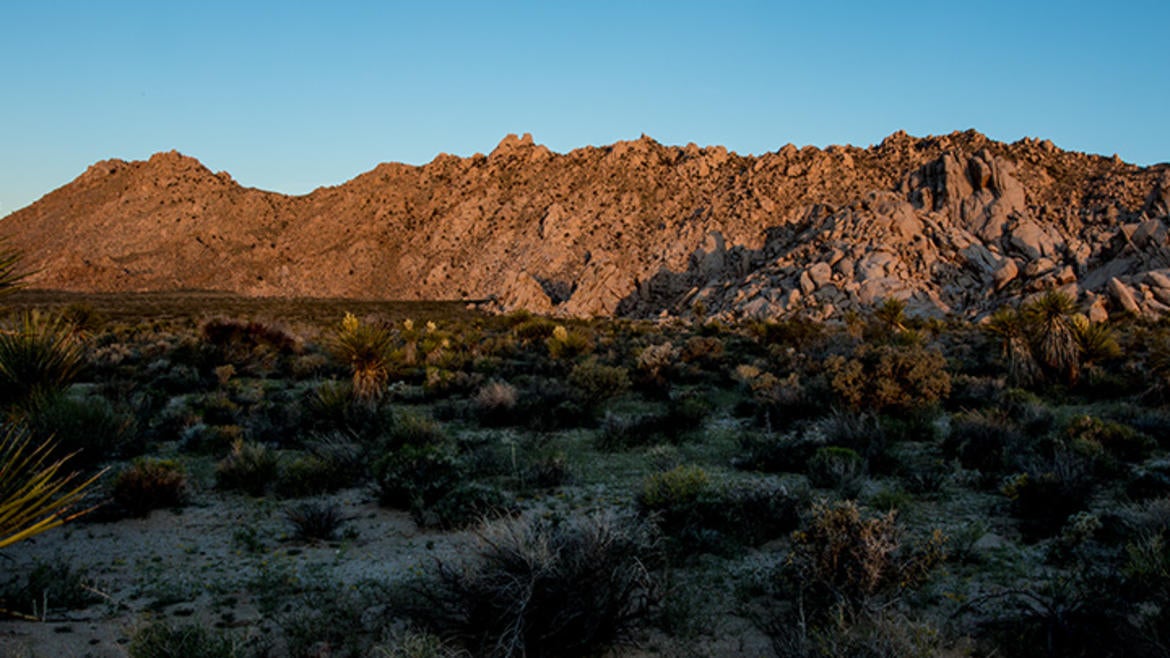
Sweeney Granite Mountains Desert Research Center is located in the rugged Granite Mountains of the East Mojave Desert. High plateaus and ridges dominated by piñon-juniper woodland and sagebrush descend precipitously to the east in highly fractured granitic canyons. Massive pinnacles and broken, rocky terrain eventually give way to densely vegetated bajadas and washes, supporting creosote bush scrub, a unique community of enriched mixed woody and succulent scrub, and other habitat types. Springs and seeps are common.
Variation in habitat, hydrology, and elevation supports widely diverse plant and animal life, including more than 460 species of vascular plants, two amphibians, thirty-four reptiles, 138 birds, and 42 mammals. The reserve also protects a dense concentration of archeological sites left by Chemehuevi and other Native American tribes. This NRS reserve lies within the Mojave National Preserve.
Sweeney Granite Mountains Desert Research Center administers two satellite reserves. The Sacramento Mountains Reserve lies on the steep slopes and flat bajadas of the Sacramento Mountains in the East Mojave Desert. It satellite site supports several Sonoran Desert plant species, including Bigelow teddy bear cholla, along with a small, disjunct colony of ocotillo, one of this species’s northernmost occurrences. The Old Woman Mountains satellite site occupies approximately 105 hectares (265 acres) of a range roughly 80 km (50 mi.) southeast of the reserve. It is surrounded by lands largely administered by the U.S. Bureau of Land Management.
Field Courses
Many university courses use the reserve, including geology, archaeology, physiology, ecology, evolution, and photography.
Public Outreach
Field trips for high school students from nearby communities; site visits by outdoor groups; integration of research with National Park Service; displays and guided tours; volunteer programs.
Regional Plant Inventory
Reserve personnel are conducting a floristic study of the East Mojave that includes the collection and deposit of more than 5,000 specimens in the reserve herbarium.
Selected Research
- Linkages between biotic and physical components of piedmont landscapes.
- Characterization of microbial communities and desert soil crusts.
- Ecomorphology of desert lizards.
- Systematics of scorpions.
- Ecology of ants.
- Systematics of wasps and bees.
- Bighorn sheep demographics and dietary requirements.
- Rattlesnake life history/ distributional ecology.
- Kangaroo rat physiology and foraging behavior.
- Ecology and evolutionary factors that maintain genetic diversity in annual plants.
- Long-term demographics of desert shrubs.
Contact Information
Jim Andre
Sweeney Granite Mountains
Desert Research Center
P.O. Box 101
Kelso, CA 92351
760-733-4222
granites@telis.org
Sweeney Granite Mountains website
Location
East Mojave Desert, San Bernardino County, 128 km (80 mi.) east of Barstow.
Facilities
Housing and laboratory w/ AC electricity, full conveniences for up to 12 researchers; small trailers for long-term researcher housing; cabin w/ DC electricity for classes of up to 40 persons; campground and conference/lecture room for up to 40.
Reserve bibliography
The reserve bibliography includes citations of journal articles, books, theses, art, and other works published about or based on activities conducted at the reserve.
Sweeney Granite Mountains Bibliography
Personnel
Reserve director, assistant directors, and steward on site.
Size
3,600 hectares (8,900 acres); plus satellite reserves with additional 107 hectares (265 acres) in Old Woman Mountains and 239 hectares (591 acres) in Sacramento Mountains.
Elevation
Granite Mountains: 1,128 to 2,071 m (3,700 to 6,796 ft.)
Sacramento Mountains: 700 to 915 m (2,300 to 3,000 ft.)
Average Precipitation
22 cm (8.9 in.) per year at Granite Cove, 1280 m (4,200 ft.) elevation
Average Temperatures
July maximum: 33 ºC (93 ºF)
December minimum: -1 ºC (31 ºF)
